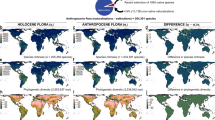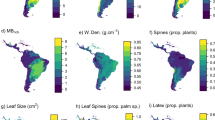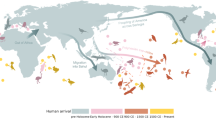Abstract
Most people can name a mammal or bird that has become extinct in recent centuries, but few can name a recently extinct plant. We present a comprehensive, global analysis of modern extinction in plants. Almost 600 species have become extinct, at a higher rate than background extinction, but almost as many have been erroneously declared extinct and then been rediscovered. Reports of extinction on islands, in the tropics and of shrubs, trees or species with narrow ranges are least likely to be refuted by rediscovery. Plant extinctions endanger other organisms, ecosystems and human well-being, and must be understood for effective conservation planning.
This is a preview of subscription content, access via your institution
Access options
Access Nature and 54 other Nature Portfolio journals
Get Nature+, our best-value online-access subscription
$29.99 / 30 days
cancel any time
Subscribe to this journal
Receive 12 digital issues and online access to articles
$119.00 per year
only $9.92 per issue
Buy this article
- Purchase on Springer Link
- Instant access to full article PDF
Prices may be subject to local taxes which are calculated during checkout


Similar content being viewed by others
Data availability
All new data on plant extinction and rediscovery analysed during this study are available as supplementary files linked to this published article. The data used for comparison with all seed plants are from the World Checklist of Selected Plant Families and are, or will soon become, publicly available from http://wcsp.science.kew.org.
References
Pimm, S. L. & Raven, P. Nature 403, 843–845 (2000).
Brummitt, N. A. et al. PloS ONE 10, e0135152 (2015).
Pelletier, T. A., Carstens, B. C., Tank, D. C., Sullivan, J. & Espindola, A. Proc. Natl Acad. Sci. USA 115, 13027–13032 (2018).
The IUCN Red List of Threatened Species Version 3.1 (IUCN, accessed June 2016).
Ceballos, G. et al. Sci. Adv. 1, e1400253 (2015).
Dunn, R. R. Conserv. Biol. 19, 1030–1036 (2005).
Regnier, C. et al. Proc. Natl Acad. Sci. USA 112, 7761–7766 (2015).
Bellard, C., Rysman, J. F., Leroy, B., Claud, C. & Mace, G. M. Nat. Ecol. Evol. 1, 1862 (2017).
Gray, A. The ecology of plant extinction: rates, traits and island comparisons. Oryx, 1–5 (2018).
Fonseca, C. R. Conserv. Biol. 23, 1507–1515 (2009).
Linnaeus, C. Species Plantarum (Salvius, 1753).
Regnier, C., Fontaine, B. & Bouchet, P. Conserv. Biol. 23, 1214–1221 (2009).
De Vos, J. M., Joppa, L. N., Gittleman, J. L., Stephens, P. R. & Pimm, S. L. Conserv. Biol. 29, 452–462 (2015).
Pimm, S. L. et al. Science 344, 987 (2014).
Bellard, C., Cassey, P. & Blackburn, T. M. Biol. Lett. 12, 20150623 (2016).
Pimm, S. L., Russell, G. J., Gittleman, J. L. & Brooks, T. M. Science 269, 347–350 (1995).
Turvey, S. T. & Fritz, S. A. Philos. Trans. R. Soc. B 366, 2564–2576 (2011).
Bebber, D. P. et al. Proc. Natl Acad. Sci. USA 107, 22169–22171 (2010).
Mooers, A. O., Goring, S. J., Turvey, S. T. & Kuhn, T. S. in Holocene Extinctions (ed. Turvey, S.T.) 263–277 (Oxford Univ. Press, 2009).
Cronk, Q. Plant extinctions take time. Science 353, 446–447 (2016).
Myers, N., Mittermeier, R. A., Mittermeier, C. G., da Fonseca, G. A. B. & Kent, J. Nature 403, 853–858 (2000).
Beech, E., Rivers, M., Oldfield, S. & Smith, P. P. J. Sustain. For. 36, 454–489 (2017).
World Checklist of Selected Plant Families (WCSP, 2018); http://wcsp.science.kew.org/
Welch, J. N. & Beaulieu, J. M. Diversity 10, 63 (2018).
Nic Lughadha, E. M. et al. in State of the World’s Plants 2017 (ed. Willis, K. J.) 72–77 (Royal Botanic Gardens, 2017).
Keith, D. A. & Burgman, M. A. Biol. Conserv. 117, 41–48 (2004).
Fisher, D. O. & Blomberg, S. P. Proc. R. Soc. B 278, 1090–1097 (2011).
Magallón, S., Gomez-Acevedo, S., Sanchez-Reyes, L. L. & Hernandez-Hernandez, T. New Phytol. 207, 437–453 (2015).
Pagel, M. Nature 401, 877–884 (1999).
Blomberg, S. P., Garland, T. & Ives, A. R. Evolution 57, 717–745 (2003).
Fritz, S. A. & Purvis, A. Conserv. Biol. 24, 1042–1051 (2010).
Brummitt, R. K. World Geographical Scheme for Recording Plant Distributions. For International Working Group on Taxonomic Databases For Plant Sciences (TDWG) 153 (Hunt Institute for Botanical Documentation, Carnegie Mellon University, 2001).
Acknowledgements
R.G. is grateful to numerous people and institutions for support during data collection (Supplementary Dataset 1). A.M.H. acknowledges funding by the Swedish Research Council Formas (grant No. 2012-1022-215). We are grateful to S. Pimm and two anonymous reviewers for comments that improved an earlier draft and to B. walker for statistical advice.
Author information
Authors and Affiliations
Contributions
A.M.H., R.G. and M.S.V. designed the study, based on data collected by R.G.; A.M.H. analysed the data with contributions from S.Z.F., E.N.L. and M.S.V.; and A.M.H. wrote the paper with contributions from all authors. All authors approved the final version.
Corresponding authors
Ethics declarations
Competing interests
The authors declare no competing interests.
Additional information
Publisher’s note: Springer Nature remains neutral with regard to jurisdictional claims in published maps and institutional affiliations.
Supplementary information
Supplementary Information
Supplementary Information, Supplementary References, Supplementary Figure 1 and Supplementary Table 1
Supplementary Dataset 1
Database of modern extinction in seed plants
Supplementary Dataset 2
The IUCN Red List of extinct seed plant species
Rights and permissions
About this article
Cite this article
Humphreys, A.M., Govaerts, R., Ficinski, S.Z. et al. Global dataset shows geography and life form predict modern plant extinction and rediscovery. Nat Ecol Evol 3, 1043–1047 (2019). https://doi.org/10.1038/s41559-019-0906-2
Received:
Accepted:
Published:
Issue Date:
DOI: https://doi.org/10.1038/s41559-019-0906-2
This article is cited by
-
Structural biology in the Anthropocene epoch
Nature Structural & Molecular Biology (2024)
-
Keita (Aptandraceae-Olacaceae s.l.), a new genus for African species previously ascribed to Anacolosa, including K. deniseae sp. nov., an Endangered submontane forest liana from Simandou, Republic of Guinea
Kew Bulletin (2024)
-
Complete chloroplast genome molecular structure, comparative and phylogenetic analyses of Sphaeropteris lepifera of Cyatheaceae family: a tree fern from China
Scientific Reports (2023)
-
Novel plant–frugivore network on Mauritius is unlikely to compensate for the extinction of seed dispersers
Nature Communications (2023)
-
Revising the global biogeography of annual and perennial plants
Nature (2023)



